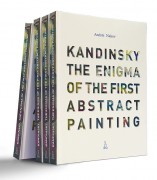|
Kandinsky, the Enigma of the First Abstract Painting Andréi Nakov Cracow 2015 257 x 200 mm, 232 pages laminated hardback, 86 colour illustrations ISBN 978-83-89831-25-5 Également disponible en version française: Kandinsky, l’énigme du premier tableau abstrait Price : 37.00 EUR Add to cart |
Painted in Munich in 1911, Painting with a Circle is Kandinsky’s first abstract composition – and the first abstract painting in the history of modern art. Yet for long decades it was an enigma for art historians and even for the artist himself, for whom its creation raised complex issues. After Kandinsky fled Russia in December 1921, leaving Painting with a Circle “on deposit” in Moscow, it vanished from the surface of history. The artist was not even able to obtain a photograph of it from the Soviet authorities. In effect, the painting was reduced to silence. So total was the cultural censorship to which it was subjected that it was thought to have been lost. Then, in the late 1970s, long after the artist’s death, it was rediscovered in the USSR, although it was not publicly displayed for the first time before 1989. Yet until today this capital work in modern art history has received scant recognition from scholars and has thus not been given the place it deserves in our cultural Pantheon.
More than an innovative interpretation of Painting with a Circle, this book reveals the multiple levels of censorship that beset the creation of the first purely abstract composition and in many ways beset it still. Casting an entirely new look on it in the light of hitherto unpublished documents relating to the circumstances of its creation and its cultural sources, Andréi Nakov finally does justice to its historical and artistic importance. The outcome of an exhaustive and exemplary research, his book enables us to grasp the cultural context of the period in which it was painted and to understand the essence of Kandinsky’s aesthetic.
ABOUT THE AUTHOR
The Slavic-born, French-educated art historian Andréi Nakov has organized a number of major museum exhibitions over the last four decades: Berlin in 1977, London in 1984, Tokyo in 1989, Madrid in 1990 and others. Since the early 1970s his studies on art theory and essays on Dada, Constructivism, Suprematism and Abstract Art in general have been published in French, German, English and in many other languages. His books on Kazimir Malevich: Kazimir Malewicz. Catalogue raisonné, Paris, Editions Adam Biro 2002 and his extensive four-volume study Malevich, Painting the Absolute, Lund Humphries, London 2010 are regarded as authoritative works on this artist.
CONTENTS
F O R E W O R D
REASONS FOR STUDYING A CENSORED PAINTING
Note Concerning the Translation
C H A P T E R 1
KANDINSKY’S FIRST ABSTRACT PAINTING: LOOKING BEYOND THE LEGENDS
A Difficult Paternity
A Succesful Adoption
Nina Kandinsky’s Devotion
Creation is an Explosion
The “First Abstract Painting” is Displayed for the First Time in Public
C H A P T E R 2
DIONYSUS VERSUS APOLLO
Kandinsky’s Relationship with the St. Petersburg Union of Youth
“At the Time Everyone Was Reading Blavatsky”
Toward a New Laocoon?
“The Religion of Music”
The Subconscious: the Mainspring of a Difficult Creation
C H A P T E R 3
THE GESTATION OF THE FIRST ABSTRACT PAINTING
“Invisible in their Limpid Lives, the Solitary Ones...”
“Refraining from the Forms of Conventional Beauty”
“A Beam of Light Shining into the Future”
“The Inrush of Forms”
“In Art that Which is Veiled is far More Powerful”
“A Snake not Quite Able to Slough off its Skin”
C H A P T E R 4
“WONDERFUL IS THE CIRCLE”
“The Circle is the Synthesis of the Greatest
Oppositions”
Postscript: In the Labyrinth of Symbols
A P P E N D I X
“The Square! The ‘Square’ of Malevich...”:
Kandinsky's Letters to Alfred Barr
Bibliography
List of illustrations
Index

